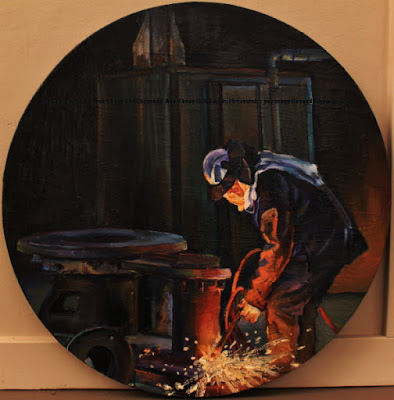The now derelict 'William Wallbank and Sons' was a foundry on the Parramatta Road, Auburn, built in 1932.
I've been painting the machinery before it is all stripped out and sent to a scrap metal yard.
 |
AWW5 Oxycutting, William Wallbank + Sons foundry
2017 oil on canvas 46cm tondo |
Some of the ladles and other machinery that couldn't be sold intact were being broken up for scrap by oxycutting.
During this exciting process, I painted some small and medium circular canvases, known as tondos.
In Art, the circular format of the tondo was often used for religious subjects.
Extreme chiaroscuro was also exploited by artists such as Caravaggio, to heighten the contrast between the gloomy background and the intensely illuminated saints or angels.
The fire in the dim interior gave the scene a mysterious atmosphere, reminding me of the nocturnal paintings of one of my favourite artists, Georges de la Tour.
Figures in his paintings are enveloped in shifting accretions of darkness - hands and features picked
out by pooling, smoky light.  |
AWW5 Oxycutting, William Wallbank + Sons foundry
2017 oil on canvas 46cm tondo" |
Oxycutting is one of the oldest welding processes.
A torch is used to heat the metal to its kindling temperature. When
it's cherry red, a stream of oxygen is focused on the heated part and chemically reacts
with the ferrous metal, producing more heat and forming molten iron oxide which is then
blasted out of the cut.
The
melting point of the iron oxide is about half that of the metal being
cut, so it will immediately turn to liquid iron oxide and flow away from
the cutting zone.
 |
AWW5 Oxycutting, William Wallbank + Sons foundry
2017 oil on canvas 46cm tondo" |
Starting a cut in the middle of a workpiece is known as piercing.
Once it has started, steel can be cut surprisingly quickly, far faster than if it were completely melted through.
Sometimes remnants of iron oxide remain on the workpiece, forming a hard "slag" which can be removed by tapping or grinding.  |
AWW6 Oxycutting, William Wallbank + Sons foundry
2017 acrylic on paper 56 x 76cm |
The
hottest part of the flame is
approximately 6,000 °F (3,300 °C) - hot enough to easily
melt steel.
But the flame of the cutting torch is not intended to melt the metal, just bring it to its ignition temperature.
The rest of the heat is created by the burning metal itself.

AWW5 Oxycutting, William Wallbank + Sons foundry
2017 oil on canvas 46cm tondo"
.
A basic oxy-acetylene rig is faster than a petrol-driven cut-off grinder, as well as lighter, smaller, quieter and not as prone to severe vibration.
Oxy-acetylene torches can easily cut through ferrous materials as thick as 200 mm.
However oxy-acetylene has its limitations. It can only efficiently cut low- to medium-carbon steels and wrought iron.
High-carbon steels aren't suitable because the melting point of the slag is closer to the melting point of the parent meta.The slag from the cutting action mixes with the clean melt near the cut, which means the oxygen doesn't reach the clean metal to burn it. With cast iron, graphite between the grains interferes with the cutting action of the torch. Stainless steels can't be cut either with this process, because the material doesn't burn as easily.

AWW7 Oxycutting, William Wallbank + Sons foundry 2
2017 oil on canvas 46cm tondo
Painting this was fascinating, but there was an undercurrent of sadness, as it
marked the point of no return.
The life of the former foundry was at an end, and its vivisection will be the last fires lit inside.
"Some say the world will end in fire,
Some say in ice.
From what I’ve tasted of desire
I hold with those who favor fire.
But if it had to perish twice,
I think I know enough of hate
To say that for destruction ice
Is also great
And would suffice."
"Fire and Ice" by Robert Frost
Related posts
Rust Bucket
Steady Rest
Scar Tissue
Wrong side of the tracks - Darling Island Bond and Free
All fired up
Eveleigh - Industrial heritage artist at work
Irons in the fire
White Bay Power Station - Inside Out
Power Base - Artist in Residence at the White Bay Power Station































